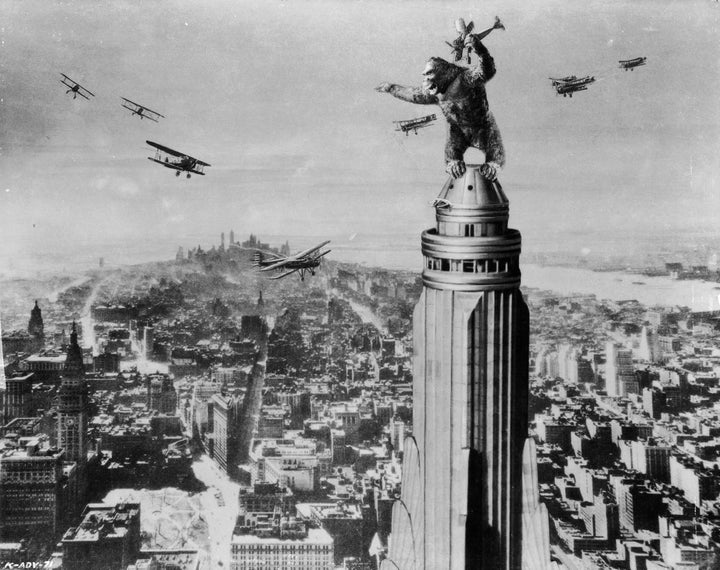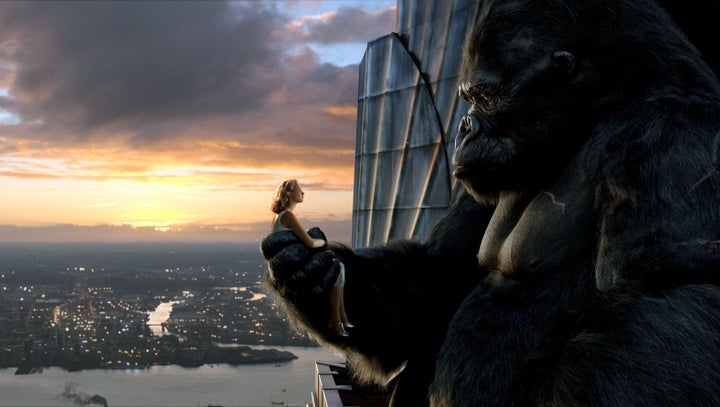Long before the word “franchise” dominated Hollywood, King Kong stormed the Empire State Building and spawned a century of refurbishings. The gargantuan ape, who debuted in 1933, has been the subject of three American reboots, numerous sequels and spinoffs, an animated television series, multiple novelizations, video games, theme-park rides, an ABBA jam, a “Sunset Boulevard” joke and a “Rocky Horror Picture Show” lyric. This weekend, he will invade multiplexes once again.
King Kong is a preeminent emblem of our nostalgic popular culture, which tends to recycle the same stories with increasing regularity. Wowing audiences through pioneering visual effects, the original ― the first film to play two of New York’s largest-capacity theaters at once ― was so beloved that Time magazine christened its 1952 re-release the “movie of the year” over such titles as “Singin’ in the Rain,” “The Greatest Show on Earth” and “High Noon.”

Audiences have flocked in droves every time Kong headlines marquees. When adjusted for inflation, the 1976 remake starring Jessica Lange and Jeff Bridges made about $225 million, the seventh-highest-grossing movie of its year. Peter Jackson’s update, a technical marvel that cost a record-breaking $207 million to make, collected $685 million worldwide, the fifth-largest sum of 2005. This latest version, the bloated “Kong: Skull Island,” arrives as part of Warner Bros.’ Marvel-esque blueprint for a shared universe that will pit the primate against Godzilla, the giant lizard with whom he first appeared in 1962’s “King Kong vs. Godzilla.” (The billing is inverted this time around. “Godzilla vs. Kong,” a tie-in with 2014’s lucrative “Godzilla” redo, is slated for 2020.)
This Kong stands taller and bulkier than his predecessors, though the film’s budget is about $17 million less than that of Jackson’s adaptation, which swapped puppetry and animatronics for CGI. More ape for more economy. It’s the ultimate encapsulation of Hollywood’s franchise mania.

In fact, the template for big-screen sequelization can be traced to “King Kong” and the 1930s’ other monster flicks, which together shaped the stencil for the horror genre. 1931’s “Dracula” was based on the popular Bram Stoker novel, which had already inspired “Nosferatu” and a stage play. The same year, “Frankenstein” modified a play that was itself an adaptation of Mary Shelley’s Gothic prose.
Count Dracula and Frankenstein’s monster both appeared in numerous sequels, spinoffs and parodies. If today’s cinematic universes (superhero and otherwise) are tentpoles for Hollywood’s intellectual property, blame it on Universal Monsters, the horror series that lasted through the 1950s and united many of the studio’s creatures. But Kong, like the mummy Imhotep before him and The Wolf Man after him, was something Dracula and Frankenstein’s monster weren’t: an original character. Reboots are equal-opportunity affairs. All of these boogeymen still routinely appear, digitalized and far noisier.

An interesting fixture of “King Kong” is the degree to which different films project different political and social concerns while retaining the original story’s roots. The 1933 prototype can be read as a metaphor for the chaos of the Great Depression, or at least an escape from it for the era’s moviegoers.
The 1976 remake, which arrived during the decade’s energy crisis, revolves around an oil executive hungry to deplete an uncharted island’s untapped natural resources. In 2005, Jackson eschewed most overt politics, preferring to romanticize the olden days of show business.
“Kong: Skull Island,” in which a government-endorsed squadron hunts for monsters in the South Pacific, takes place against the backdrop of the Vietnam War. It pays homage to “Apocalypse Now,” Francis Ford Coppola’s 1979 Vietnam epic influenced by Joseph Conrad’s imperialistic Heart of Darkness. There’s even a slideshow of the real-life bloodshed. Samuel L. Jackson plays an Army warmonger convinced his fleet can vanquish any danger, including an oversized simian and the other life-threatening creatures roaming the island’s jungles.

Until now, King Kong movies had failed to improve upon critical theories concerning the story’s possible racial allegory. From the moment the first “Kong” hit theaters, its narrative about a savage black beast who falls in love with a white damsel in distress (played by Fay Wray) while townsfolk panic was seen as an offensive metaphor about African-Americans.
In his 1973 novel Gravity’s Rainbow, Thomas Pynchon outlined the concept as evidence of the country’s racial paranoia about white women dating black men. Substituting Jessica Lange and Naomi Watts for Wray, the next two remakes did little to rectify this thesis. “Kong: Skull Island,” however, bypasses the human-beast romance. Brie Larson plays the only significant female character, a self-sufficient “anti-war photographer” whose affection for Kong doesn’t result in some feral courtship.
Between the technological advances and the shapeshifting political undertones, “King Kong” has become one of Hollywood’s most symbolic properties. The times change, the people evolve, the effects balloon, but the gorilla is still there, waiting to be conquered by herds invading his homeland. He’s not so bad when you get to know him. (Plus, John C. Reilly is on hand to steal the show this time.)
As more movies become TV series and more TV series become Netflix reboots, maybe it’s comforting to know King Kong is out there for our re-digestion. But how many scripts for fresh stories died so Kong could rise again? For money-hungry studios, it’s of no concern: Moviegoers will pound their chests in excitement every time.

